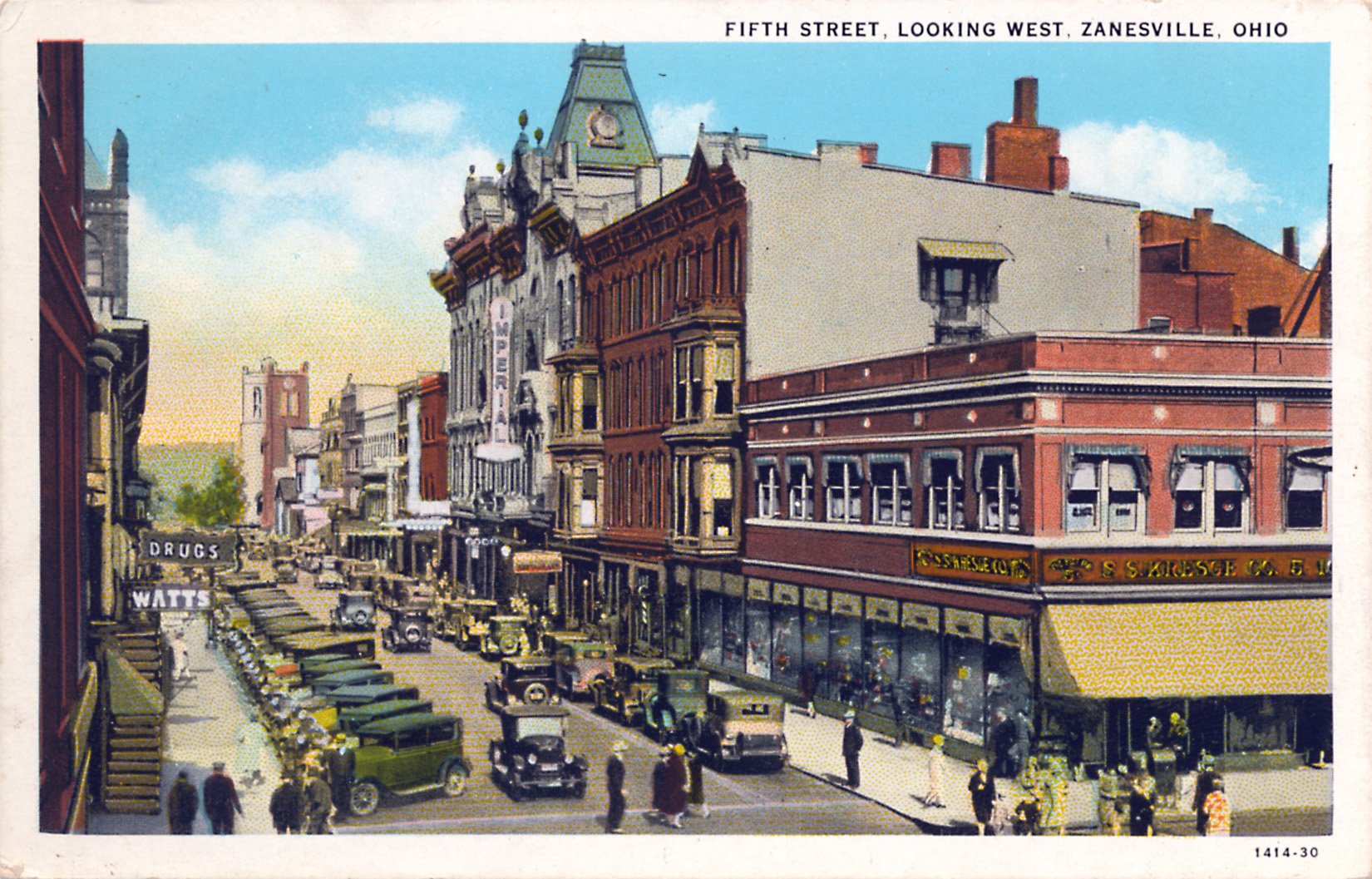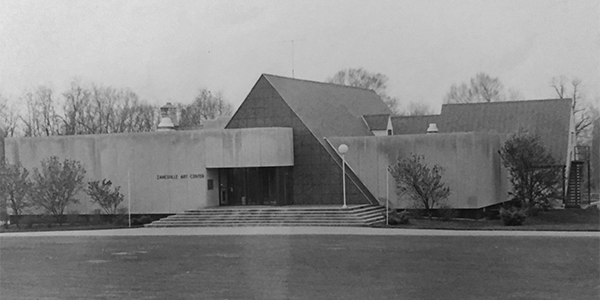The History of the Zanesville Museum of Art
Portrait of Edward Ayers, Founder, Zanesville Museum of Art,
In 1933, the Zanesville industrialists and philanthropists Mr. Edward M. Ayers and Mrs. Klara K. Ayers envisioned a cultural institution in Zanesville, Ohio and commissioned “A Cultural Survey of Zanesville Ohio with Recommendations for a Civic Art Centre”.
At the beginning of the twentieth century, the city of Zanesville, which is located 55 miles due east of the state’s capital, Columbus, Ohio, was a prosperous manufacturing center. With a population of 23,500 people, abundant natural resources including clay and silica deposits (mined by the Ayers Mineral Company), and rivers and railways to transport goods, Zanesville was the industrial center for art, utilitarian, and industrial pottery production by the 1920s.
Downtown Zanesville, Ohio, 5th Street, Circa 1910
Art Pottery Built Zanesville
Large, notable manufacturers included the S.A. Weller Pottery Company, the J. B. Owens Pottery Company, Roseville Pottery Company, the American Encaustic Tiling Company, and the Mosaic Tile Company. The cultural survey recognized the pottery industry’s impact on the community, the wealth the industry generated, and the artists of stature the manufacturer’s attracted to Zanesville. Capitalizing on these findings, in 1934, an architectural Master Plan positioned a cultural arts center just north of Zanesville across the Licking River in McIntire Park. Although never realized, the plan included a visual and performing arts facility, a large green space and recreation area with a sculpture garden, walking paths, and an outdoor performance area.
Weller Pottery Company, Postcard, Circa 1900
Zanesville Art Institute, Circa 1940, Located at the corner of Adair and Maple Avenues.
The Zanesville Museum of Art (ZMA) was officially established two years later in 1936 as the Zanesville Art Institute (ZAI) by Mr. and Mrs. Edward Ayers who donated art, a Renaissance Revival residence adapted for purpose, and an endowment. The Institute, located north of downtown Zanesville on Maple and Adair Avenues, offered the public free admission, art classes, performance spaces, and exhibitions.
The Ayers’ collection of regional glass and ceramics and their collection of American and European paintings, sculpture, and works on paper, including works Peter Paul Rubens, Hiram Powers, David Teniers (The Younger), Paulus Moreelse, and Thomas Gainsborough were featured in an imported English seventeenth-century panel room. Over the next 40 years, the Institute was the cornerstone of the cultural community and welcomed as many as 22,000 visitors annually. The ZAI grew despite the city’s post-industrial decline after World War II when most ceramic manufacturers closed.
The original Dunlop house, located at 620 Military Road.
In 1974, the ZAI launched its first fundraising campaign raising $300,000 to relocate. One year later, the ZAI sold the Maple and Adair Avenue facility, and purchased and repurposed a spacious suburban residence situated on five acres of land at 620 Military Road. The new facility was located two miles north of the Maple and Adair Avenues and opened in 1977 as the Zanesville Art Center (ZAC).
The Zanesville Art Center in 1977, after the house was remodeled.
Six years later in November 1983, the Art Center launched its second fundraising campaign and raised $350,000 to expand ZAC. Construction began in 1984, and the Art Center reopened to the public in July 1985 with a new 7,000 square foot south wing addition that provided additional space for programs, exhibitions, and storage. ZAC continued to provide free admission, art classes, and permanent exhibitions to the public, but it was the north Zanesville community who frequented ZAC events and programs and supported the cultural institution.
In 2000, ZAC launched its third fundraising campaign to expand the Art Center once again. By September 2021, having raised $1,900,000, ZAC ended its $3 million capital campaign and secured a $1,100,00 building loan. ZAC completed construction in 2003 on a more expansive three-story addition to the south wing of the building, adding galleries and extra collection storage space. ZAC’s 30,000 square foot facility stored and exhibited 3,000+ works of arts and hosted education programs and special events.
Demolition during one of the remodels.
The Great Recession of 2007–2009 strained the institution’s budget and compelled ZAC to reduce expenses and deaccession art. Although these measures stabilized the operating budget, paid off the building loan, and funded the new Ayers Collection Fund, facility maintenance was deferred, and admission fees were introduced. In 2008, the Zanesville Art Center was renamed the Zanesville Museum of Art (ZMA), however, the rebranding effort was never fully completed (wayfinding street signs and the museum’s stone entry gates read Zanesville Art Center) nor was the new name fully embraced. By 2013, the ZMA was still called ZAC by many, attendance dropped to 3,000 annual visitors, education programs and events were further reduced, and the ZMA garnered a reputation as the “country club on the hill.”
Since 2014, the ZMA completed several self-studies and a strategic plan; increased its financial capacity, doubling the annual operating budget and creating a cash reserve; completed necessary, deferred facility maintenance projects; added full- and part-time staff, hiring its first education and marketing team members; launched a series of free and low-cost mission-related adult and children's programs including workshops, classes, lectures, and special events; and reconnected with the community. The ZMA partnered with the local and regional organizations including Ohio Arts Council, the Ohio Citizens for the Arts, Muskingum County Community Foundation, Muskingum County Library System, Muskingum County History, Big Brothers and Big Sisters, Head Start, Ohio University Zanesville, Zane State College, The Artist Colony of Zanesville, the Zanesville Arts Project, and the Girl Scouts among other organizations and broadened the institution’s impact among underserved audiences.
The ZMA hosted the Prize in 2015.
On March 14, 2020, the ZMA temporarily closed its facility to the public due to local, state, and federal health and safety guidelines to prevent the spread of the coronavirus (Covid-19). By March 23, 2020, new online programs, events, and exhibitions were launched and all ZMA staff were retained and retrained to complete a site-wide digitization and collection inventory project, creating an online searchable collection database. The health emergency provided an opportunity for the museum to plan for its future.
Over the next five years, the ZMA is poised to increase visibility, visitor ship, event programming, staff, and its collection as it positions itself as a nationally recognized regional museum specializing in American art pottery.
About the Zanesville Museum of Art
The Zanesville Museum of Art (ZMA) is an arts and cultural cornerstone of Zanesville, Muskingum County, and Appalachian Ohio. Each year, the ZMA:
Welcomes on average 12,000 visitors
Offers thought-provoking exhibitions from its permanent collection of 9,000+ works of art
Presents temporary traveling exhibitions, and
Hosts 170+ free and low-fee public educational programs for learners of all ages including lectures, concerts, exhibition openings, book discussions, art classes, workshops, summer camps, and fourth and fifth-grade curriculum for Zanesville City Schools.










